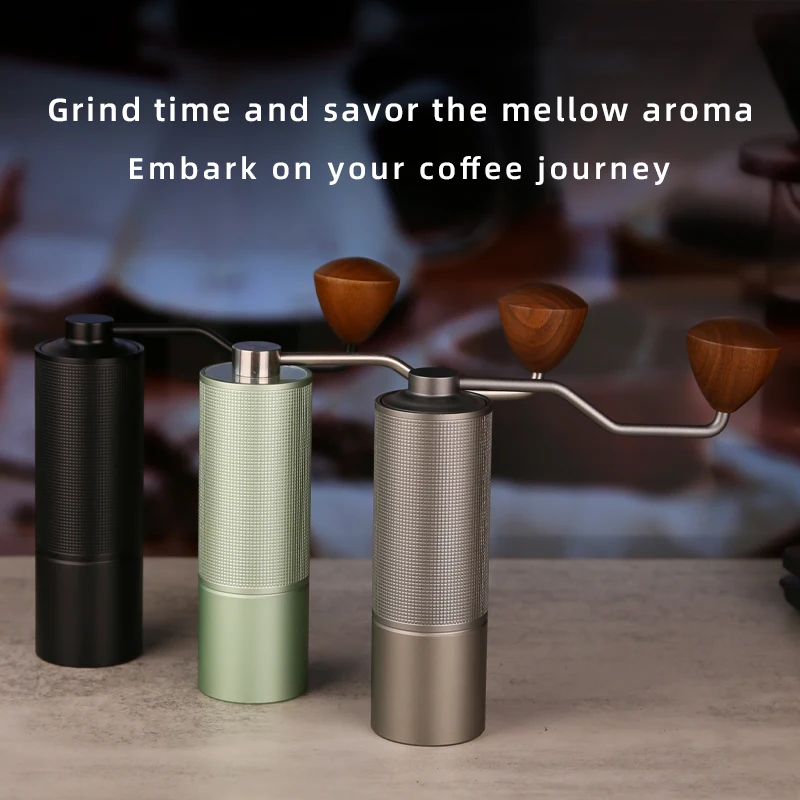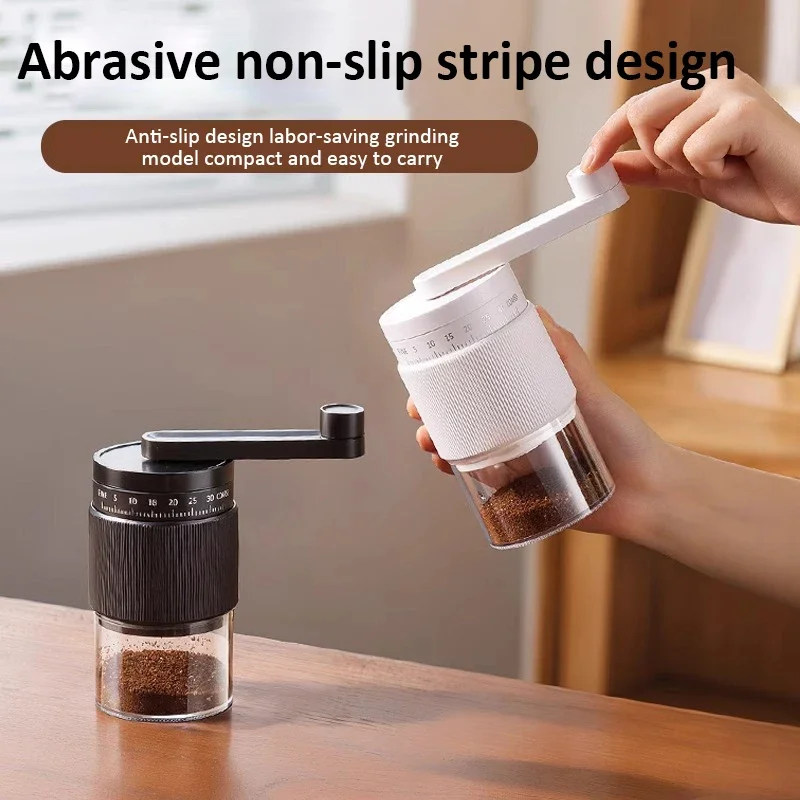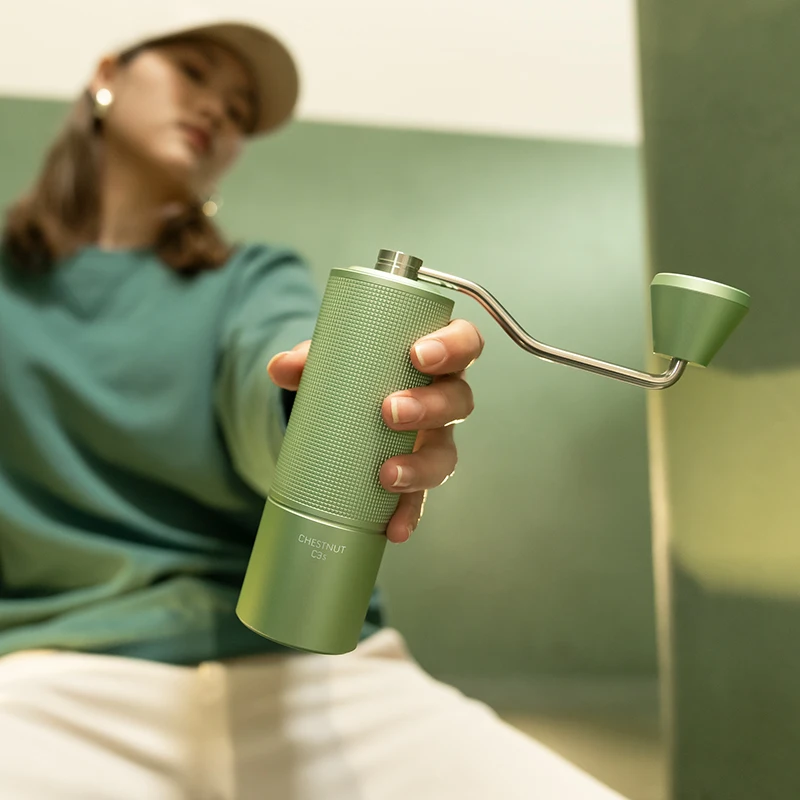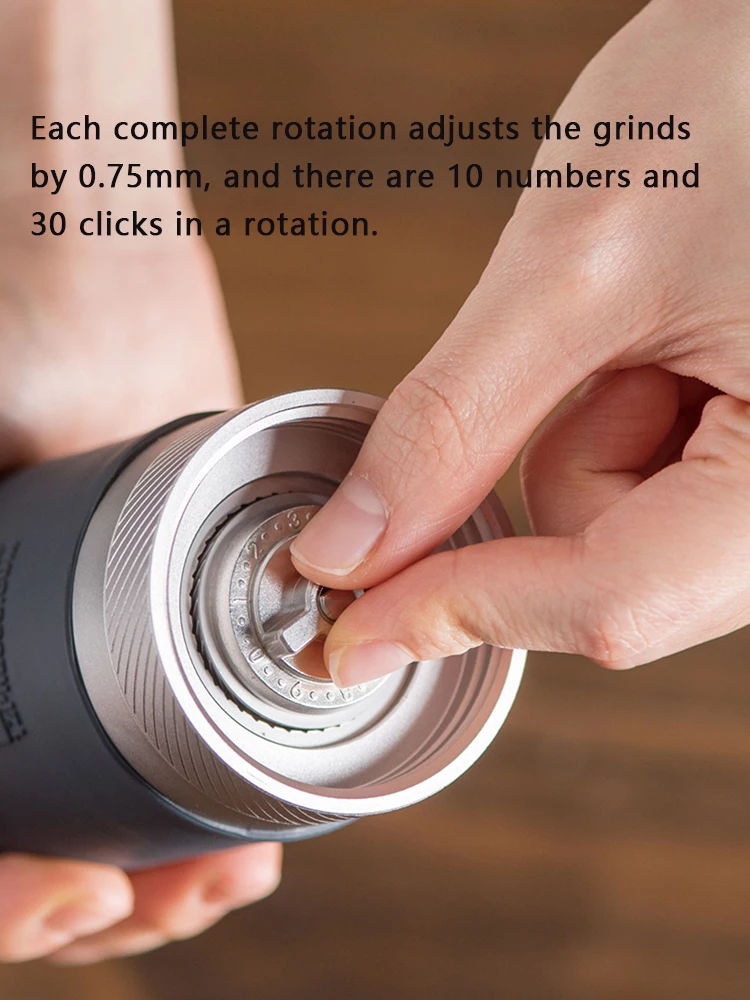Introduction: Understanding Why Grind Consistency Matters for Coffee Quality
Achieving the perfect cup of coffee begins long before water touches the grounds. It starts with how evenly and consistently your coffee beans are ground. Grind consistency refers to how uniform the coffee particles are after grinding – ideally, they should all be roughly the same size.
Why does this matter? When water passes through coffee grounds during brewing, it extracts flavors differently depending on the particle size:
- Too fine particles (called “fines”) over-extract quickly, creating bitter notes
- Too large particles (called “boulders”) under-extract, resulting in sour, weak flavors
- Uniform particles extract at the same rate, creating balanced flavor
When your grind lacks consistency, you end up with both over and under-extracted flavors competing in your cup – a muddled flavor experience rather than a clean, distinct one.
Among the factors affecting grind consistency, burr diameter stands out as particularly significant. The size of the grinding burrs in your coffee grinder can dramatically impact how uniformly your coffee beans are processed. Understanding this relationship helps coffee enthusiasts make informed decisions about the equipment that will best serve their brewing needs.
In this comprehensive guide, we’ll explore how burr diameter influences your daily coffee experience, why it matters for mastering espresso precision grind settings, and whether bigger truly means better when it comes to coffee grinding.
The Fundamental Relationship: Do Larger Burrs Produce More Consistent Grinds?
The short answer is yes – generally, larger burr diameters tend to produce more consistent coffee grounds, but the relationship is more nuanced than simply “bigger is better.”
Larger burrs provide more grinding surface area, which allows coffee beans to be processed more efficiently and with greater precision. With increased cutting surface, the coffee particles have a higher chance of being cut to similar sizes rather than crushed or broken irregularly. This increased surface area is a key factor in achieving the particle size uniformity that coffee enthusiasts seek.
Commercial coffee shops overwhelmingly choose larger burr grinders for consistency reasons. There’s a practical wisdom behind this industry standard – when consistency matters at high volumes, larger burrs deliver more reliable results.
However, burr diameter exists within a system of other important factors. A large but poorly manufactured burr will underperform compared to a smaller, precision-crafted one. Think of burr diameter as one important ingredient in a recipe, rather than the entire meal.
The relationship between burr size and coffee grind quality is significant but works alongside other critical elements that we’ll explore throughout this guide. Understanding these relationships helps you make informed decisions beyond simply choosing the biggest option available.
The Science of Grinding: How Burr Diameter Affects Particle Size Distribution
To understand why burr diameter matters, we need to examine what actually happens during the grinding process. As coffee beans enter the grinder, they travel between two burrs – one stationary and one rotating. The beans are progressively broken down into smaller and smaller pieces as they move from the wider outer section toward the narrower gap between burrs.
With larger burrs, several key advantages emerge:
First, larger burrs create a longer grinding path. Coffee beans travel further between the entry point and the final grinding zone, allowing for more gradual size reduction. This progressive breakdown results in fewer “boulders” (oversized particles) that can lead to sour, under-extracted coffee.
Second, larger burrs can operate at lower RPMs (rotations per minute) while maintaining the same grinding speed. This is a simple matter of physics – a larger circumference covers more ground with each rotation. These slower speeds generate significantly less friction and heat during grinding.
Heat reduction is critical for preserving coffee flavor. When grinding generates excess heat, it can prematurely release volatile compounds responsible for aroma and flavor, essentially “cooking” your coffee before brewing. Larger burrs help maintain lower temperatures, preserving these delicate compounds.
Additionally, larger burrs typically pair with more powerful motors that provide greater stability during grinding. This stable torque helps maintain consistent pressure and cutting action, leading to more uniform particle size throughout the grinding process.
For those seeking maximum consistency, flat burr hand grinders often provide excellent results by combining quality burrs with the natural stability of manual grinding, eliminating motor variability entirely.
Critical Factors Beyond Size: What Else Impacts Grind Consistency
While burr diameter receives significant attention, it’s just one element in a complex system that determines grind consistency. Several other factors often have equal or greater impact:
Burr Geometry and Design
* Tooth pattern and sharpness often outweigh pure diameter
* Cut pattern determines how beans are broken down
* Modern designs focus on optimizing particle shape, not just size
Burr Alignment
* Critical for even grinding across the entire burr surface
* Misalignment creates inconsistent gap width
* Larger burrs are more sensitive to alignment issues
* Even premium large burrs perform poorly when misaligned
Material and Manufacturing Precision
* Steel quality and hardness affect cutting consistency
* Manufacturing tolerances determine performance limits
* Heat treatment and finishing processes impact durability
Motor Quality and Stability
* Consistent speed under load prevents particle variation
* Power delivery affects how beans engage with burrs
* Vibration control maintains proper cutting angles
In many cases, a smaller burr set with superior geometry, perfect alignment, and high manufacturing precision will outperform a larger but lower-quality set. This explains why some modestly sized premium grinders can compete with or surpass larger commercial models.
Understanding the critical impact burr alignment has on your coffee can help you properly maintain your grinder for optimal performance. Regular alignment checks often yield more improvement than upgrading to larger burrs.
Flat vs. Conical: How Burr Type Interacts with Diameter
Beyond diameter, the fundamental design of the burrs significantly impacts grind consistency. Coffee grinders typically use one of two burr configurations: flat or conical.
Flat Burrs:
* Consist of two parallel, ring-shaped discs with teeth
* Tend to produce more uniform particle sizes (unimodal distribution)
* Often preferred for filter coffee where clarity is desired
* Generally require more precise alignment, especially at larger diameters
* Typically generate more heat than conical burrs of similar size
Conical Burrs:
* Feature a cone-shaped burr fitting inside a ring-shaped outer burr
* Produce a wider range of particle sizes (bimodal distribution)
* Often create more “fines” which can benefit espresso body
* Generally more forgiving with alignment issues
* Usually generate less heat during operation
When examining diameter effects, the burr type adds another layer of complexity. Large flat burrs excel at producing extremely uniform particles, which can create clean, distinct flavor notes in filter coffee. Large conical burrs, meanwhile, often create a more textured distribution that many espresso enthusiasts prefer for rich, full-bodied shots.
The ongoing debate between flat vs. conical burr manual grinders reflects the fact that neither design is inherently superior – they simply create different grinding profiles that suit different brewing methods and taste preferences.

Practical Considerations for Home Baristas: Is Bigger Always Better?
For home coffee enthusiasts, the question becomes practical: do you actually need large burrs, or are they overkill for typical home use?
While commercial environments benefit enormously from larger burrs due to volume demands, home users face different considerations:
When larger burrs provide meaningful benefits:
* For espresso brewing, where extreme consistency significantly impacts extraction
* When grinding daily for multiple people or brewing methods
* For users who can detect subtle flavor differences and prioritize maximum clarity
* When speed matters (larger burrs grind faster at the same RPM)
When medium-sized burrs may be sufficient:
* For single-cup brewing where heat buildup is minimal
* For casual brewers who may not notice incremental improvements in consistency
* When space and budget constraints are significant factors
* For those who primarily use medium to coarse grind settings
Home grinders typically range from 38mm to 64mm burrs, while commercial grinders often feature 64mm to 98mm burrs. The sweet spot for many home users falls in the 48-58mm range, providing excellent consistency without the expense and space requirements of commercial-sized equipment.
For those seeking quality without excessive size, manual coffee burr grinders often provide excellent consistency in compact packages, sometimes outperforming larger electric grinders through superior burr quality and alignment.
Debunking Common Myths About Burr Diameter and Grind Consistency
Several persistent myths about burr diameter can lead coffee enthusiasts astray:
Myth: Bigger burrs are always better regardless of other factors
Fact: Quality, design, and alignment often matter more than pure size. A well-made 48mm burr set can outperform a poorly designed 64mm set.
Myth: Small burrs always produce more fines
Fact: Burr geometry and speed influence fines production more than diameter alone. Some small premium burrs produce remarkably few fines.
Myth: Large burrs automatically mean better coffee
Fact: Brewing skill, coffee quality, and water chemistry have far greater impact on cup quality than the difference between decently-sized burrs.
Myth: Only professional baristas need large burrs
Fact: While professionals benefit from large burrs for volume reasons, any coffee enthusiast can appreciate good consistency regardless of burr size.
Myth: Larger burrs are maintenance-free
Fact: Larger burrs actually require more precise alignment and regular maintenance to perform optimally.
Understanding these realities helps put burr diameter in proper perspective. For a deeper dive into performance differences, exploring a detailed large vs. small burr grinders analysis can provide valuable insights for making an informed decision.
Commercial vs. Home Use: When Larger Burrs Make the Most Difference
The context of use dramatically changes the importance of burr diameter. Commercial environments present fundamentally different challenges than home settings:
Commercial Requirements:
* High-volume grinding (potentially pounds per hour)
* Continuous operation generating significant heat
* Need for consistent results across hundreds of drinks
* Multiple users with varying skill levels
* Durability under heavy daily use
Home User Requirements:
* Small-batch grinding (typically 15-30 grams at a time)
* Intermittent use with cooling between sessions
* Consistency for personal taste preferences
* Single operator who learns equipment quirks
* Space-efficient design for kitchen counters
These different demands explain why cafes invest in large commercial grinders. When grinding continuously, the heat dissipation and speed advantages of larger burrs become essential rather than optional.
For home users, particularly those who single-dose (measure beans before grinding), these advantages diminish. Small cooling breaks between doses essentially eliminate heat buildup concerns, and grinding speed becomes less critical when preparing just one or two drinks at a time.
Quality precision manual grinders often represent an excellent compromise, offering commercial-grade grind consistency in compact forms ideal for home use.

How to Evaluate Grinders Beyond Just Burr Diameter
When selecting a coffee grinder, consider these factors alongside burr diameter to make a comprehensive assessment:
Alignment Capability:
* Can the burrs be aligned properly?
* Are there adjustment mechanisms?
* Does the design maintain alignment over time?
Build Quality and Stability:
* Is the chassis rigid enough to prevent flex during grinding?
* Are the bearings high-quality and properly supported?
* Does the grinder remain stable during operation?
Motor Characteristics (for electric grinders):
* Does it maintain consistent RPM under load?
* Is it powerful enough for the burr size?
* Does it operate at appropriate speeds for the burr design?
Adjustment Mechanism:
* How precisely can grind size be controlled?
* Is adjustment repeatable and consistent?
* Does it maintain settings during use?
Practical Usability:
* How much retention occurs between grinds?
* Is cleaning and maintenance straightforward?
* Does it fit your workflow and space?
When researching grinders, be wary of marketing that focuses exclusively on burr size while ignoring these equally important factors. Many excellent manual burr mills demonstrate that thoughtful engineering across all components often matters more than maximizing any single specification.
Fine Adjustment Hand Grinder, Precision Manual Grinder, Travel Coffee Grinder
Price range: $185.11 through $494.63 Select options This product has multiple variants. The options may be chosen on the product pageHand Burr Grinder, Hand Crank Coffee Grinder, Manual Espresso Grinder, Portable Coffee Grinder
Price range: $262.72 through $300.22 Select options This product has multiple variants. The options may be chosen on the product pageManual Burr Mill, Manual Coffee Grinder Stainless Steel, Manual Coffee Mill Grinder, Mechanical Coffee Grinder
Price range: $127.26 through $130.32 Select options This product has multiple variants. The options may be chosen on the product pageHand Burr Grinder, Manual Coffee Grinder Stainless Steel, Precision Manual Grinder
Price range: $183.64 through $187.52 Select options This product has multiple variants. The options may be chosen on the product page
The Future of Burr Technology: Innovations Beyond Size
While burr diameter has been a focus for many years, cutting-edge developments in grinding technology are exploring new frontiers beyond simply making burrs larger:
Advanced materials research is creating burr surfaces that maintain sharpness longer while generating less heat during grinding. These materials allow smaller burrs to perform with consistency previously requiring much larger diameters.
Sophisticated geometry innovations are reimagining tooth patterns and cutting angles. Some newer designs produce remarkably uniform particle distribution despite modest diameters, challenging conventional wisdom about size requirements.
Anti-static technologies are addressing one of grinding’s persistent challenges – the clinging of fine particles to surfaces due to static electricity. These advances reduce clumping and retention, improving dose consistency regardless of burr size.
Hybrid approaches combining different cutting zones within the same burr set show promise for optimizing both speed and consistency. These multi-stage grinding processes can achieve results that traditional designs require much larger diameters to match.
These innovations suggest that the future of grinding may focus less on raw diameter and more on sophisticated engineering across multiple performance factors.
Are Larger Burrs Worth the Investment? A Practical Assessment
For coffee enthusiasts considering an upgrade, the question ultimately becomes: is the premium price of larger burrs justified for your specific needs?
Who benefits most from larger burrs:
* Dedicated espresso brewers seeking maximum extraction precision
* Those who can discern subtle flavor differences in their cup
* Users grinding for multiple brewing methods who value versatility
* Anyone prioritizing grind speed and efficiency
Who might find diminishing returns:
* Casual coffee drinkers primarily using medium-coarse settings
* Those on a budget who could invest more in better beans
* Users with limited counter space in their kitchen
* People who primarily brew with methods more forgiving of slight inconsistency
Before investing in a larger burr grinder, consider whether improving other aspects of your coffee routine might yield more noticeable improvements. Fresh beans, proper water quality, and refining brewing technique often provide more significant upgrades to cup quality than incremental grind consistency improvements.
For those exploring proper extraction parameters across different brewing methods, understanding the ultimate espresso grind size chart can help determine whether your current grinder meets your needs or if an upgrade would provide meaningful benefits.

FAQ: Common Questions About Burrs and Grind Consistency
Can I upgrade the burrs in my existing grinder to larger ones?
In most cases, no. Grinders are designed around specific burr sizes, and the motor, chassis, and adjustment mechanisms are calibrated for those dimensions. However, some grinders allow replacement with higher-quality burrs of the same size, which can significantly improve performance.
How can I tell if my burrs are worn and affecting consistency?
Look for visible dullness on the cutting edges, increased grinding time, excessive heat generation, and noticeably less uniform grounds. Most quality burrs should last through 500-1000 pounds of coffee before significant performance degradation.
What is burr “seasoning” and does it improve consistency?
Burr seasoning refers to the process where new burrs become smoother and more consistent after grinding several pounds of coffee. This subtle polishing can reduce fines production and improve consistency, particularly with higher-quality burrs.
Do larger burrs retain more coffee between uses?
Not necessarily. Retention has more to do with grinder design, exit path, and anti-static measures than burr size alone. Some large flat burr grinders have excellent low-retention designs, while some smaller grinders have problematic retention issues.
How important is regular cleaning for maintaining grind consistency?
Extremely important. Even the largest, highest-quality burrs will perform poorly when clogged with coffee oils and particles. Regular cleaning (every 1-2 weeks for daily users) helps maintain optimal performance regardless of burr size.
For those seeking to upgrade their grinding experience, exploring quality espresso coffee hand grinders can provide excellent consistency without the size and noise constraints of electric models.







